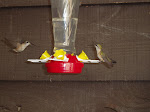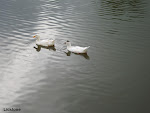The first thing I did when we moved to our new home was put up a bird feeder. With in the hour six Mountain Chickadees, four Black-capped Chickadees, two White-breasted Nuthatches & three Red-breasted Nuthatches were busy chowing down at the neighborhood's newest feeding station.
It didn't take long for word to spread & by week's end eleven different species were enjoying the offerings at our feeders.
Since then, the number of bird species I've seen in our own yard is over 70.
Not all the birds actually eat at my feeders. Some only visit the bird bath for a quick drink, while others use our field as a short pit-stop on the way to somewhere else.
Any bird on my property makes it on to my backyard list, but of course only after I've made a positive identification.
I also keep lists of all the birds I've seen close to my yard & up & down the valley. So far I have very few game or water birds on this list & with their additions I could very easily top 100.
Any one can start a bird list. Children, senior citizens & even the housebound can add a whole new dimension to backyard bird watching by doing so.
The easiest list to keep is a "check list" where you tick off each species you see.
My own check list has extra columns to record whether I've seen the male, female or juvenile of each species, if I've found their nest, how many eggs, when they hatched & for seasonal birds, the date they arrive.
The dates help me know which birds I might expect at my feeder at a certain time of year & is especially useful for predicting when my favorites, the hummingbirds will arrive.
Another list I, & millions of other birder world wide have is a "life list". This is simply recording every bird you have positively over your life time.
My own includes over 176 species out of a possible 10,000.
Some bird watchers have been known to fly all over the world just to add another species to their list. We've been to three other vcountries (Dominican Republic, Mexico & Costa Rica) & I usually spend the majority of my time looking for birds. My "world list" is growing every year.
The world record for sightings is close to 7,000, all spotted by one very serious birder!
Keeping a bird list is a fairly easy undertaking: actually identifying a certain bird can be much more confusing.
Many birds are so similar it's next to impossible to ID & even with a good field guide & binoculars, there are those birds that will forever remain unidentified.
Seasonal plumages can also create confusion.
For example, the drab olive coloured American Goldfinch transforms in to a bright, lemon yellow bird come spring. Some species sexes are so similar that you could only tell who's who by actually observing their courtship display &/or mating rituals.
In order to make a positive ID there are many factors to consider.
For instance, is it as big as a robin, small as a nuthatch etc? Take note of its shape, beak type, behaviour & colours. This will narrow it down somewhat.
Next look for wing bars, eye stripes & other important field marks.
Some field marks are visible when the bird is stationary & some are only observed when the bird is flying. A junco because of its size might easily be confused with a sparrow at first glance but when the bird flies away, the white outer tail feathers tell you that it is definitely a junco.
Listing birds is a cheap & easy form of entertainment. They are also invaluable, when combined with other birder's lists to keep track of abundance & varieties.
Vagrants from other regions or countries, swept in by storms may even adapt to our climate & remain or return year after year.
The past few years we have seen Turkey Vultures every summer & a few years ago three waaaay off course Cattle Egrets.
You could be very surprised who might show up at your feeder! I know I have been!
Subscribe to:
Post Comments (Atom)
.png)






No comments:
Post a Comment